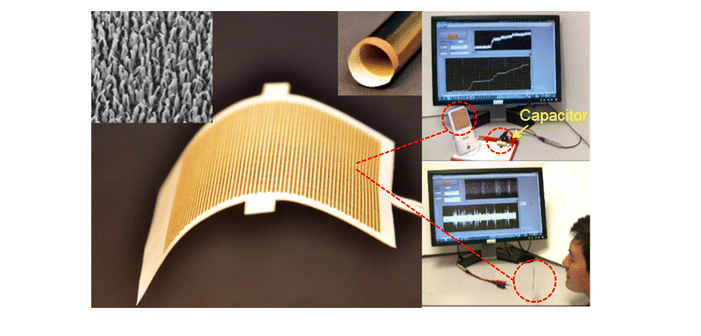Researchers at the Georgia Tech Institute of Technology have developed this super-flexible, ultrathin paper microphone which you can charge with your speech. You got the speech part right. Imagine your battery almost drained when you most need it, but you can charge it by simply shouting at it. Al ridiculous as it may sound, the practicality of it is well proven. These Georgian smarts have developed a rollable, 125 μm thin, paper-based triboelectric nanogenerator (TENG) which can derive energy from speech and can deliver a maximum power density of 121 mW/m2.

The researchers employed a laser to effect a grid of microscopic holes on paper, and later coated one side in copper and laid it over a thin sheet of Teflon, joining the two sheets at an edge. As sound waves vibrate within the two sheets differently, it causes the two sheets to connect and disconnect, thus producing electricity. This experiment is pretty similar to that where a charge is developed when someone rubs a rubber balloon against hair. This charge can be converted to several range of sound frequencies, allowing the initial sounds to be amplified.
The researchers went on to add that this ultrathin microphone is scalable for a commercial future, and could be employed in smartphones. It could be made in demandable sizes, but a stamp-sized mic inside a smartphone shall offer very little power and won’t be able to completely charge the phone.
The research team states that their concept could be adopted in quite a many applications where sound energy needs to be harvested, like in military equipments, wearable gadgets, jet engines for noise reduction and also in human ear-implant.
via- ACS
Researchers at the Georgia Tech Institute of Technology have developed this super-flexible, ultrathin paper microphone which you can charge with your speech. You got the speech part right. Imagine your battery almost drained when you most need it, but you can charge it by simply shouting at it. Al ridiculous as it may sound, the practicality of it is well proven. These Georgian smarts have developed a rollable, 125 μm thin, paper-based triboelectric nanogenerator (TENG) which can derive energy from speech and can deliver a maximum power density of 121 mW/m2.
The researchers employed a laser to effect a grid of microscopic holes on paper, and later coated one side in copper and laid it over a thin sheet of Teflon, joining the two sheets at an edge. As sound waves vibrate within the two sheets differently, it causes the two sheets to connect and disconnect, thus producing electricity. This experiment is pretty similar to that where a charge is developed when someone rubs a rubber balloon against hair. This charge can be converted to several range of sound frequencies, allowing the initial sounds to be amplified.
The researchers went on to add that this ultrathin microphone is scalable for a commercial future, and could be employed in smartphones. It could be made in demandable sizes, but a stamp-sized mic inside a smartphone shall offer very little power and won’t be able to completely charge the phone.
The research team states that their concept could be adopted in quite a many applications where sound energy needs to be harvested, like in military equipments, wearable gadgets, jet engines for noise reduction and also in human ear-implant.
via- ACS